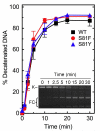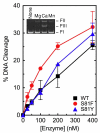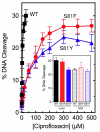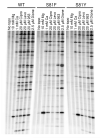Drug interactions with Bacillus anthracis topoisomerase IV: biochemical basis for quinolone action and resistance
- PMID: 22126453
- PMCID: PMC3261753
- DOI: 10.1021/bi2013905
Drug interactions with Bacillus anthracis topoisomerase IV: biochemical basis for quinolone action and resistance
Abstract
Bacillus anthracis, the causative agent of anthrax, is considered a serious threat as a bioweapon. The drugs most commonly used to treat anthrax are quinolones, which act by increasing the levels of DNA cleavage mediated by topoisomerase IV and gyrase. Quinolone resistance most often is associated with specific serine mutations in these enzymes. Therefore, to determine the basis for quinolone action and resistance, we characterized wild-type B. anthracis topoisomerase IV, the GrlA(S81F) and GrlA(S81Y) quinolone-resistant mutants, and the effects of quinolones and a related quinazolinedione on these enzymes. Ser81 is believed to anchor a water-Mg(2+) bridge that coordinates quinolones to the enzyme through the C3/C4 keto acid. Consistent with this hypothesized bridge, ciprofloxacin required increased Mg(2+) concentrations to support DNA cleavage by GrlA(S81F) topoisomerase IV. The three enzymes displayed similar catalytic activities in the absence of drugs. However, the resistance mutations decreased the affinity of topoisomerase IV for ciprofloxacin and other quinolones, diminished quinolone-induced inhibition of DNA religation, and reduced the stability of the enzyme-quinolone-DNA ternary complex. Wild-type DNA cleavage levels were generated by mutant enzymes at high quinolone concentrations, suggesting that increased drug potency could overcome resistance. 8-Methyl-quinazoline-2,4-dione, which lacks the quinolone keto acid (and presumably does not require the water-Mg(2+) bridge to mediate protein interactions), was more potent than quinolones against wild-type topoisomerase IV and was equally efficacious. Moreover, it maintained high potency and efficacy against the mutant enzymes, effectively inhibited DNA religation, and formed stable ternary complexes. Our findings provide an underlying biochemical basis for the ability of quinazolinediones to overcome clinically relevant quinolone resistance mutations in bacterial type II topoisomerases.
Figures











References
-
- Mock M, Fouet A. Anthrax. Annu. Rev. Microbiol. 2001;55:647–671. - PubMed
-
- Bossi P, Tegnell A, Baka A, Van Loock F, Hendriks J, Werner A, Maidhof H, Gouvras G. Bichat guidelines for the clinical management of anthrax and bioterrorism-related anthrax. Eurosurveillance. 2004;9:1–7. - PubMed
-
- Danzig R. Proliferation of biological weapons into terrorist hands. In: Campbell KM, editor. The Challenge of Proliferation: A Report from the Aspen Strategy Group. The Aspen Institute; Washington, D.C: 2005. pp. 65–84.
-
- Schwartz M. Dr. Jekyll and Mr. Hyde: a short history of anthrax. Mol. Aspects Med. 2009;30:347–355. - PubMed
-
- Waterer GW, Robertson H. Bioterrorism for the respiratory physician. Respirology. 2009;14:5–11. - PubMed
Publication types
MeSH terms
Substances
Grants and funding
LinkOut - more resources
Full Text Sources
Medical
Miscellaneous

